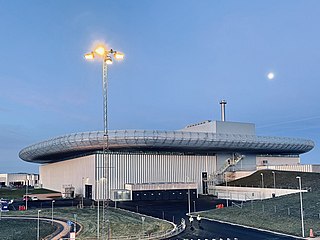
Neutron diffraction or elastic neutron scattering is the application of neutron scattering to the determination of the atomic and/or magnetic structure of a material. A sample to be examined is placed in a beam of thermal or cold neutrons to obtain a diffraction pattern that provides information of the structure of the material. The technique is similar to X-ray diffraction but due to their different scattering properties, neutrons and X-rays provide complementary information: X-Rays are suited for superficial analysis, strong x-rays from synchrotron radiation are suited for shallow depths or thin specimens, while neutrons having high penetration depth are suited for bulk samples.

Neutron scattering, the irregular dispersal of free neutrons by matter, can refer to either the naturally occurring physical process itself or to the man-made experimental techniques that use the natural process for investigating materials. The natural/physical phenomenon is of elemental importance in nuclear engineering and the nuclear sciences. Regarding the experimental technique, understanding and manipulating neutron scattering is fundamental to the applications used in crystallography, physics, physical chemistry, biophysics, and materials research.
A subcritical reactor is a nuclear fission reactor concept that produces fission without achieving criticality. Instead of sustaining a chain reaction, a subcritical reactor uses additional neutrons from an outside source. There are two general classes of such devices. One uses neutrons provided by a nuclear fusion machine, a concept known as a fusion–fission hybrid. The other uses neutrons created through spallation of heavy nuclei by charged particles such as protons accelerated by a particle accelerator, a concept known as an accelerator-driven system (ADS) or accelerator-driven sub-critical reactor.

Spallation is a process in which fragments of material (spall) are ejected from a body due to impact or stress. In the context of impact mechanics it describes ejection of material from a target during impact by a projectile. In planetary physics, spallation describes meteoritic impacts on a planetary surface and the effects of stellar winds and cosmic rays on planetary atmospheres and surfaces. In the context of mining or geology, spallation can refer to pieces of rock breaking off a rock face due to the internal stresses in the rock; it commonly occurs on mine shaft walls. In the context of anthropology, spallation is a process used to make stone tools such as arrowheads by knapping. In nuclear physics, spallation is the process in which a heavy nucleus emits numerous nucleons as a result of being hit by a high-energy particle, thus greatly reducing its atomic weight. In industrial processes and bioprocessing the loss of tubing material due to the repeated flexing of the tubing within a peristaltic pump is termed spallation.

The Open-pool Australian lightwater reactor (OPAL) is a 20 megawatt (MW) swimming pool nuclear research reactor. Officially opened in April 2007, it replaced the High Flux Australian Reactor as Australia's only nuclear reactor, and is located at the Australian Nuclear Science and Technology Organisation (ANSTO) Research Establishment in Lucas Heights, New South Wales, a suburb of Sydney. Both OPAL and its predecessor have been commonly known simply as the Lucas Heights reactor.

The Spallation Neutron Source (SNS) is an accelerator-based neutron source facility in the U.S. that provides the most intense pulsed neutron beams in the world for scientific research and industrial development. Each year, this facility hosts hundreds of researchers from universities, national laboratories, and industry, who conduct basic and applied research and technology development using neutrons. SNS is part of Oak Ridge National Laboratory, which is managed by UT-Battelle for the United States Department of Energy (DOE). SNS is a DOE Office of Science user facility, and it is open to scientists and researchers from all over the world.

Muon spin spectroscopy, also known as µSR, is an experimental technique based on the implantation of spin-polarized muons in matter and on the detection of the influence of the atomic, molecular or crystalline surroundings on their spin motion. The motion of the muon spin is due to the magnetic field experienced by the particle and may provide information on its local environment in a very similar way to other magnetic resonance techniques, such as electron spin resonance and, more closely, nuclear magnetic resonance (NMR).

Research reactors are nuclear reactors that serve primarily as a neutron source. They are also called non-power reactors, in contrast to power reactors that are used for electricity production, heat generation, or maritime propulsion.

The ISIS Neutron and Muon Source is a pulsed neutron and muon source, established 1984 at the Rutherford Appleton Laboratory of the Science and Technology Facilities Council, on the Harwell Science and Innovation Campus in Oxfordshire, United Kingdom. It uses the techniques of muon spectroscopy and neutron scattering to probe the structure and dynamics of condensed matter on a microscopic scale ranging from the subatomic to the macromolecular.

Neutron backscattering is one of several inelastic neutron scattering techniques. Backscattering from monochromator and analyzer crystals is used to achieve an energy resolution in the order of μeV. Neutron backscattering experiments are performed to study atomic or molecular motion on a nanosecond time scale.

Triple-axis spectrometry is a technique used in inelastic neutron scattering. The instrument is referred to as triple-axis spectrometer. It allows measurement of the scattering function at any point in energy and momentum space physically accessible by the spectrometer.

Neutron spin echo spectroscopy is an inelastic neutron scattering technique invented by Ferenc Mezei in the 1970s, and developed in collaboration with John Hayter. In recognition of his work and in other areas, Mezei was awarded the first Walter Haelg Prize in 1999.

The European Spallation Source ERIC (ESS) is a multi-disciplinary research facility based on the world's most powerful pulsed neutron source. It is currently under construction in Lund, Sweden. The ESS Data Management and Software Centre (DMSC) will be located in Copenhagen, Denmark. The 13 European member countries act as partners in the construction and operation of ESS. ESS will start the scientific user programme in 2023, and the construction phase will be complete by 2025. ESS is the world's most powerful next-generation neutron source, and will enable scientists to see and understand basic atomic structures and forces at length and time scales unachievable at other neutron sources.

The NA58 experiment, or COMPASS is a 60-metre-long fixed-target experiment at the M2 beam line of the SPS at CERN. The experimental hall is located at the CERN North Area, close to the French village of Prévessin-Moëns. The experiment is a two-staged spectrometer with numerous tracking detectors, particle identification and calorimetry. The physics results are extracted by recording and analysing the final states of the scattering processes. The versatile set-up, the use of different targets and particle beams allow the investigation of various processes. The main physics goals are the investigation of the nucleon spin structure and hadron spectroscopy. The collaboration consists of 220 physicists from 13 different countries, involving 28 universities and research institutes.

A neutron research facility is most commonly a big laboratory operating a large-scale neutron source that provides thermal neutrons to a suite of research instruments. The neutron source usually is a research reactor or a spallation source. In some cases, a smaller facility will provide high energy neutrons using existing neutron generator technologies.

The Los Alamos Neutron Science Center (LANSCE), formerly known as the Los Alamos Meson Physics Facility (LAMPF), is one of the world's most powerful linear accelerators. It is located in Los Alamos National Laboratory in New Mexico in Technical Area 53. It was the most powerful linear accelerator in the world when it was opened in June 1972. The technology used in the accelerator was developed under the direction of nuclear physicist Louis Rosen. The facility is capable of accelerating protons up to 800 MeV. Multiple beamlines allow for a variety of experiments to be run at once, and the facility is used for many types of research in materials testing and neutron science. It is also used for medical radioisotope production.
A Fixed-Field alternating gradient Accelerator (FFA) is a circular particle accelerator concept that can be characterized by its time-independent magnetic fields and the use of alternating gradient strong focusing.
Muon tomography is a technique that uses cosmic ray muons to generate three-dimensional images of volumes using information contained in the Coulomb scattering of the muons. Since muons are much more deeply penetrating than X-rays, muon tomography can be used to image through much thicker material than x-ray based tomography such as CT scanning. The muon flux at the Earth's surface is such that a single muon passes through an area the size of a human hand per second. Since its development in the 1950s, muon tomography has taken many forms, the most important of which are muon transmission radiography and muon scattering tomography. Muon tomography imagers are under development for the purposes of detecting nuclear material in road transport vehicles and cargo containers for the purposes of non-proliferation. Another application is the usage of muon tomography to monitor potential underground sites used for carbon sequestration.

John M. "Jack" Carpenter was an American nuclear engineer known as the originator of the technique for utilizing accelerator-induced intense pulses of neutrons for research and developing the first spallation slow neutron source based on a proton synchrotron, the Intense Pulsed Neutron Source (IPNS). He died on 10 March 2020.
Neutron resonance spin echo is a quasielastic neutron scattering technique developed by Gähler and Golub. In its classic form it is used analogously to conventional neutron spin echo (NSE) spectrometry for quasielastic scattering where tiny energy changes from the sample to the neutron have to be resolved. In contrast to NSE, the large magnetic solenoids are replaced by two resonant flippers respectively. This allows for variants in combination with triple axes spectrometers to resolve narrow linewidth of excitations or MIEZE for depolarizing conditions and incoherent scattering which are not possible with conventional NSE.









